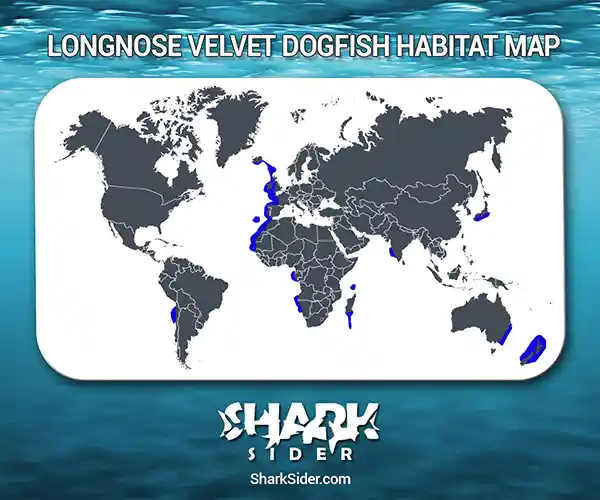The Longnose Velvet dogfish belongs to the family of sleeper sharks. It occurs in patches throughout the Subtropical Southern Hemisphere. It is a common but less studied species.
Longnose Velvet Dogfish Scientific Classification |
|
| Kingdom | Animalia |
| Phylum | Chordata |
| Class | Chondrichthyes |
| Order | Squaliformes |
| Family | Somniosidae |
| Genus | Centroselachus |
| Scientific name | C. crepidater |
Description
Adult males have an average length of 64-67 cm (2.1-2.2 ft). Females grow up to 82 cm (2.7 ft). The maximum recorded specimen is an adult male measuring 130 cm (4.2 ft).
These sharks have a characteristic elongated snout and a small, circular mouth with long furrows, lance-shaped upper teeth, and bladelike, curved lower teeth. The body is slender and does not taper from the pectoral region. It has a black or brown coloration and lighter rear fin margins. The dermal denticles are reasonably large, with smooth, oval crowns.
The dorsal fins are similar-sized and edged with small spines. The first dorsal is positioned at the base of the pectoral fins and has a noticeable ridge. The rear tip of the second dorsal almost reaches the tail fin. There is no anal fin.
Where do they live
Map Of The Longnose Velvet Dogfish Shark’s Habitat

This shark is mainly distributed between the Eastern Pacific and Atlantic Oceans and parts of the Indian Ocean. In the Southwest Pacific, it commonly inhabits the coast of New Zealand and southern Australia.
It is a bottom-dwelling species, living on or near the ocean floor at depths of 270-1,500 m (886-4,921 ft).
Behavior
Dietary
Their primary diet consists of bony fish and cephalopods.
Reproductive
This species follows an ovoviviparous mode of reproduction. Adults mate throughout the year, with litters of 4-8 pups measuring 28-35 cm (11-13.8 in). Males become sexually mature when they reach 64 cm (2.1 ft) at around 15 years old. The age of maturity in females is 22 years, at a length of 82 cm (2.7 ft). Both sexes can live up to 54 years.
Adaptations
They share features such as a keen sense of smell and sight, streamlined bodies, and razor-sharp teeth with other shark species.
Human interactions
Even though it is a common, widespread shark, it is increasingly threatened by commercial fishing methods such as longlines and bottom trawlers. It is primarily caught as a bycatch, but there is demand for its liver oil and meat to make fishmeal. Its flesh is high in mercury and is unfit for human consumption.
The IUCN has thus classified this species as “Near Threatened” or “NT.” Additionally, under the New Zealand Threat Classification System, the New Zealand Department of Conservation lists it as “Not Threatened” with the modifier “Secure Overseas.”
